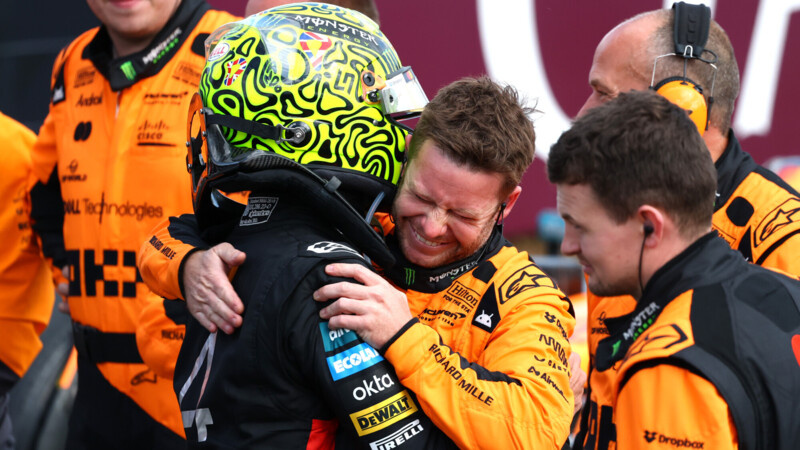The British Grand Prix is a highlight of the Formula 1 calendar, a place where history is made and dreams can come true. For McLaren driver Oscar Piastri, this year`s race at Silverstone offered a tantalizing glimpse of a potential maiden victory, a performance that saw him challenging for the lead against reigning world champions. However, a specific moment behind the safety car, followed by a contentious penalty, turned that dream into a frustrating `what if`, sparking renewed debate across the paddock about the consistency of F1 stewarding decisions.
The Incident Under Scrutiny
Piastri had driven a superb race, navigating challenging conditions and keeping pace with the front-runners. Hopes were high for a significant result, perhaps even a victory, especially after periods under the safety car bunched up the field. It was during the second safety car period, just before the restart on lap 21, that the critical moment occurred.
As the safety car prepared to pull into the pits, Piastri, leading the train of cars, executed a maneuver common among drivers: a hard jab on the brakes. The purpose? To keep vital temperature in the tires and brakes, essential for performance immediately after a restart. However, this specific braking point was substantial – telemetry later revealed a reduction from 218 kph (135 mph) down to 52 kph (32 mph), achieved with a brake pressure of 59.2 psi. This abrupt deceleration, coinciding awkwardly with the safety car extinguishing its lights relatively late, caught the car behind, driven by Max Verstappen, by surprise. Verstappen had to take evasive action, momentarily overtaking Piastri before correcting himself. The stewards, reviewing the data, deemed Piastri`s action a breach of Article 55.15 of the Sporting Regulations, which prohibits “erratic braking nor any other maneuver which is likely to endanger other drivers” behind the safety car. A 10-second penalty was swiftly applied.
Frustration and Confusion
For Piastri, the penalty was a bitter pill. Despite maintaining his characteristic composure when speaking publicly, his frustration was evident. He felt he had driven a strong race and that the outcome was taken out of his hands. “It obviously hurts at the moment,” he stated, acknowledging a different kind of pain than a simple lack of pace. He emphasized that he didn`t do anything differently from the first restart and didn`t intend to gain an advantage, feeling his actions were a standard part of preparing for the green flag.
The key point of contention, echoed by others including Verstappen and Red Bull Team Principal Christian Horner, was the perceived inconsistency of the ruling. Horner pointed to a similar incident involving George Russell in Canada that had gone unpenalized, suggesting Piastri`s penalty was “what you would expect,” implying Russell`s lack of penalty was the anomaly. Verstappen also noted he had experienced similar scenarios before without the lead car being penalized.
The Stewards` Stance and the Data
However, the stewards` analysis presented a technical justification for their decision, distinguishing Piastri`s case. Their statement highlighted the magnitude of the braking event – the significant pressure (59.2 psi) and the drastic speed reduction (100 mph drop). While acknowledging Verstappen gave the position back, they focused on Piastri`s action as the *cause* of the erratic behavior in the train. The comparison to the Canada incident, according to the stewards` data, showed clear differences: Russell`s brake pressure was significantly lower (30 psi), and his speed reduction was less severe (just over 40 mph). These technical distinctions, combined with potentially different phases of the safety car procedure and track conditions, provided the basis for treating the incidents differently under a strict interpretation of the rules, whether that satisfied calls for consistency is another matter.
McLaren Team Principal Andrea Stella felt the penalty was harsh, suggesting the late timing of the safety car lights and potentially even “race craft” from following competitors could have exacerbated the situation`s appearance. Nevertheless, the decision stood.
The Outcome and Lingering Questions
The 10-second penalty, applied during Piastri`s final pit stop, dropped him behind his teammate Lando Norris. Piastri even asked the team if they could swap positions, a request he admitted knowing would likely be denied, but one born of pure competitive instinct and frustration. McLaren managed the situation professionally, explaining their strategy logic related to serving the penalty fairly. Ultimately, Norris took a popular home win, and Piastri finished second, a strong result by any measure, but undeniably one that felt like a victory lost.
The incident at Silverstone underscores the tightrope drivers walk in modern F1, where split-second decisions under immense pressure are scrutinized with microsecond precision via telemetry. It also reignites the perennial debate about how racing rules, designed for safety and fairness, are interpreted and applied in the heat of the moment. While the stewards followed their data and regulations, the feeling of a potential win slipping away due to a technical infringement in a chaotic race scenario leaves a lingering question mark over what constitutes `erratic` and how consistency can truly be achieved when every incident presents unique variables.


